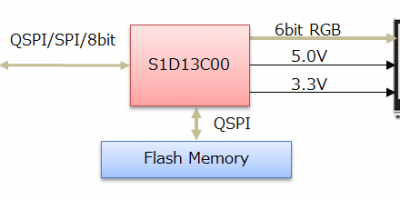Memory display controller eliminates external components
Designed for memory displays in wearable products, the S1D13C00 memory display controller is suitable for products that require a low-power memory display.
Samples of the S1D13C00 are shipping now, with volume production due to begin in April 2018.
The S1D13C00 is a memory display controller that can be connected to a variety of different microcontrollers. With three types of built-in host interfaces (indirect 8-bit parallel, QSPI, and SPI), the controller supports a variety of microcontrollers used by customers. With ordinary LCDs with a memory function, even still images have to be refreshed. On memory LCDs, however, once an image is drawn on the display, it can be held there without being refreshed. This helps limit power consumption and saves battery life.
The controller has 96kbyte RAM, operates between 1.8 and 5.5V, with a typical power consumption of 0.4-microA (typical).
In addition to the embedded memory LCD controller for graphics, the S1D13C00 provides two programmable supply voltages for powering the different panels that are supported. This feature eliminates the need for external components and interface software development, allowing manufacturers to reduce product size. The S1D13C00 controller also has a six-bit RGB parallel interface that accelerates video playback.
The controller also features an event processor that renders video without going through a host CPU to extend the battery life of products. The liquid crystal controller circuitry has been modified so that images can be rapidly written at speeds of up to 30 frames per second, adds Epson.
The controller chip also has embedded peripheral circuits, among them a real-time clock/calendar (RTC), four-channel DMAC, QSPI, and sound generator.
For graphics acceleration, the S1D13C00 has 0, 90, and 270 degree image rotation.
Drawing functions are line, rectangle and ellipses. For image conversion, it uses bitmap copying (with scaling and rotation or horizontal and vertical shearing) and alpha-blending.
Pictured is an example of an automatically updated display using the event processor.




